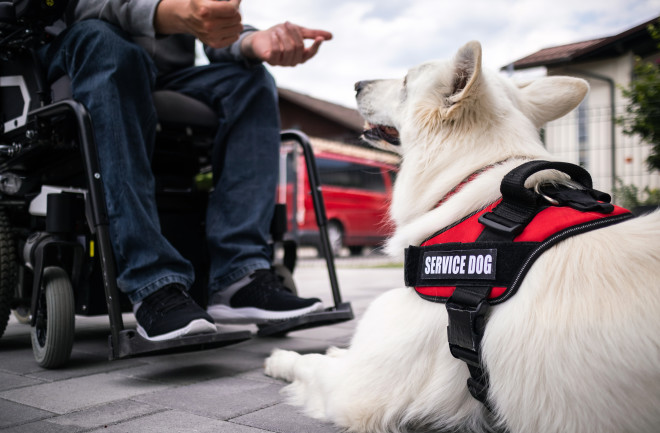In 2018, a woman at New Jersey’s Newark Liberty International Airport attempted to board a cross-country United Airlines flight with a peacock named Dexter.
Although the woman claimed the bird — which had its own seat purchased for the trip — was an emotional support animal, the airline refused to let Dexter travel due to health and safety concerns. Soon after, Delta Airlines announced a tightening of regulations for service and emotional support animals, noting that customers were attempting to board flights with turkeys, snakes, spiders and sugar gliders, among other species.
It's not hard to find numerous stories like these — including a passenger whose support pig began pooping in the aisle of a U.S. Airways flight before take-off. But all of them might make you wonder the same thing: What exactly constitutes as a service animal?
What Is a Service Animal?
In short, the answer depends on whom you ask.
Different nations, states and organizations have differing definitions, but there is near-universal recognition of dogs as the primary species of service animal.
Read More: Study Shows Calm Service Dogs Reduce PTSD Symptoms
In the United States, things are pretty straightforward. The U.S. Department of Justice revised service animal regulations for the Americans with Disabilities Act (ADA) in 2010. Under titles II and II of the ADA, dogs are the only species fully recognized as service animals, which are defined as those “individually trained to do work or perform tasks” for disabled persons.
These canines guide the blind, signal the deaf, pull wheelchairs, alert others of medical emergencies like seizures, and calm the autistic and those with PTSD-induced anxiety attacks. Service dogs are allowed in all public areas, including most areas in hospitals and on public transit, though they must be kept under control by their handlers.
Service Animals vs. Emotional Support Animals
It should be noted that emotional support animals are considered distinct from service animals — at least, according to the guidelines established by the ADA. If emotional support animals don’t do any of the aforementioned tasks, they don’t count as service animals and a public place can deny their presence.
Legislation like the Fair Housing Act, however, has more leeway. Federal rules allow a disabled person reasonable accommodations in finding a place to live, and this can include the waiving of “no pets” policies for creatures deemed to be emotional support animals.
Which Animals Can Fly With You?
Until recently, the Airline Carrier Access Act required airlines to accept, within reason, any animal trained to provide assistance or emotional support. Animals like snakes, reptiles, ferrets, rodents, spiders and sugar gliders, however, were usually considered a no-go for most airlines.
But as more and more unusual animals began showing up in airport security lines, the ACAA was revised. Those with disabilities could travel with emotional support animals, provided they had the right documents for the animal and it wasn’t dangerous or disruptive. Those documents include proof of someone’s emotional disability, as assessed by a licensed mental health professional.
In December 2020, though, the U.S. Department of Transportation issued its most recent revision: Airlines no longer had to accept emotional support animals and could treat them as pets, thus subjecting them to airline pet fees which those with service or support animals traditionally have bypassed.
Read More: Are Japan’s Animal Cafes a Bad Idea?
The airlines responded accordingly, and many — including Frontier, United, Alaska, Delta, American and Spirit — have now banned emotional support animals from their flights.
Are There Any Loopholes for Service Animals?
There’s one significant addendum to the ADA, however, and it involves miniature horses.
They can be individually trained to work with disabled people do count as service animals, but the horses must be housebroken, under control, and be present in a space without compromising space or safety. On an airplane, that can be very questionable. As such, airlines must allow service dogs but can opt out of boarding a service horse.
As service animals, the mini horses must be less than 34 inches tall and weight no more than 100 pounds. They’re usually used as guide animals for those with visual disabilities, and their life spans (up to 35 years) can provide much longer durations of service than dogs.
Do Helper Monkeys Count as Service Animals?
In addition to dogs and miniature horses, monkeys are also used to assist humans in various tasks.
In particular, capuchin monkeys can be used for mobility-based help like turning pages, inserting straws into bottles, retrieving dropped objects and even scratching itches. Like miniature horses, capuchins can live for 30 to 40 years, offering potentially much longer relationships between a disabled person and their furry helper.
It’s important to note that the ACAA doesn’t recognize these primates as service animals, so bringing one on an airplane is also a tenuous proposition at best.
Essentially, while other animal species may in fact produce truly helpful emotional support, the designation of service animal belongs to a much more select few.
Read More: The Surprising Benefits of Emotional Support Animals

